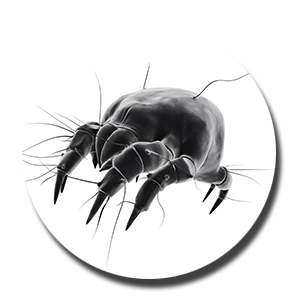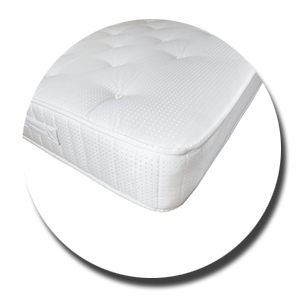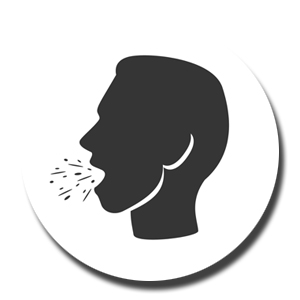House dust mites are considered to be responsible for 60% of allergies and could be involved in the emergence of new allergies, such as asthma, for which the first symptoms often go often unnoticed.
What is the mechanism?

The House dust mites are rarely in contact with the allergic patient. They live deep down inside the mattress, where the living conditions for them are ideal.
The allergy is not due to contact with house dust mites but from their excretions, which are mixed with house dust.
In this mechanism, the mattress plays a leading role. In the mattress, the dust mites find their food, evacuate their excretions, reproduce themselves, and ultimately die.
Role of the mattress
- The mattress plays a leading role in the allergy to house dust mites :
The temperature of a bedroom is generally too low to provide good living conditions for house dust mites.
The mattress is consequently their favorite home.
Indeed, every night, the mattress provides the warmth of a body, that the dust mites look for. It is not rare that a temperature of 28°C is conserved throughout the day inside your mattress.

- Like the temperature, the humidity within the mattress is fairly constant and this also attracts house dust mites
- The mattress is also where you lose the most your dead skin cells (shedding), bringing the necessary food for dust mites to live on.
- It is generally in the deepest part of your mattress that the house dust mite proliferates with two main consequences: its excrements and its corpse which decompose in really thin particles (usually a few microns). These particles are very allergenic.
- The mattress acts then, like a bellows every time you go to sleep and ejects millions of allergenic microparticles into the air.
- These microparticles spread not only to the rest of the bedding but also onto fitted carpets, curtains and unenclosed clothing where they wait for a movement or a jerk (as in walking, etc) to go back to the air and for the allergic patient to breathe them in.
- Enclosing the mattress in a anti-dust mite cover breaks this cycle of dust mites’ infestation and isolates the sleeper from his/her allergens.

Prévenir l’infection d’acariens
A new mattress is colonized by dust mites within 4 weeks !
How to prevent the harmful action of dust mites on allergic patients ?
1. The main culprit is the mattress
This has to be looked after at first.
If you buy a new mattress, don’t use it without putting on it a good-quality anti-dust mite cover. Thus, your mattress won’t be contaminated.

If your mattress is older than 3 months: :
- Open out the mattress and aerate it. In summer, take out the mattress from the cover to eliminate any moisture.
- Vacuum the mattress well, to remove the maximum amount of dust mites.
- Enclose the mattress with a full and good quality anti-dust mite cover. Repeat this process every six months when you clean your bedcovers.
- Put your sheet on your mattress cover.
2. Eliminate dust, where ever it is :
- Regularly vacuum curtains and fitted carpets. Replace curtains with fine, washable textiles and fitted carpets with washable flooring, where ever possible.
- Sort clothing and other textile items in your cupboards, ensure cupboards close well to protect clothing from dust.
- Vacuum the base of the bed carefully. Opt for a slatted bed base rather than a bed base made from textiles.
3.Air out the room and keep the atmosphere at under 50% humidity.
4. Regulate the temperature and maintain the room at 19°C or less.
5. Absolutely avoid the presence of pets in the bedroom.
6. Absolutely avoid the presence of pets in the bedroom.
7. Wash regulary your bedding :
Wash regularly, at 60°C or more, the rest of your bedding (duvets, pillows, bolsters, banket etc.) or enclose them in an anti-dustmite cover.
If you cannot clean them, insert them in the freezer and then carefully vacuum the bedding before enclosing them in a dust mite proof cover..

First Symptoms
Research studies show that the best results to combat allergies (especially asthma), are with anti-dust mites covers, at the first signs of an allergy.
However, the first signs of allergy to dust mites often go unnoticed:
- Wake up with red eyes
- Coughing at night or in the morning
- Waking with a blocked up nose or with an irritated larynx
- A flushed appearance to the skin upon waking
- …
These are all symptoms that warn you, to start protecting yourself and to discuss the situation with your doctor (or GP), if necessary by quoting this article.
Generally, upon observation of these symptoms, classical preventive measures allows you to reduce or eliminate the symptoms in two or three weeks.



